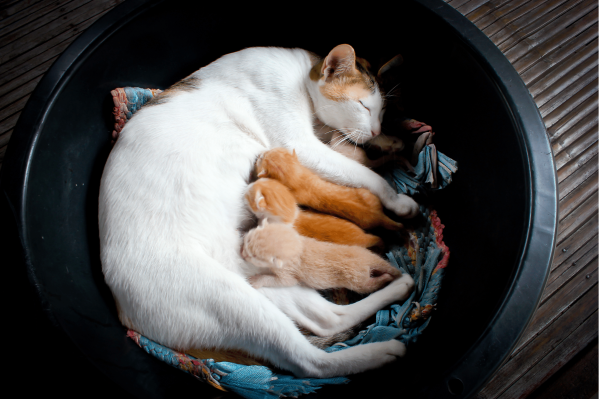Having a pregnant cat can be exciting, especially when you think about how adorable it will be to have a litter of kittens running around, but the signs of cat pregnancy can be hard to spot, especially if you’re not looking for them. Plus, if you’ve never experienced a pregnant cat before, you may be wondering how much contact you should have with your vet during this time, or if you should just let nature run its course.
It might feel overwhelming, but don't worry we're here to help. Here’s everything you need to know about what to look for to see if your cat might be pregnant, when to seek a vet’s help, and more.
When Do Cats Go Into Heat? And How Often?
Before we can fully understand cat pregnancy, we need to understand what leads your cat there: going into heat. When your cat reaches sexual maturity — a kind of puberty — she will experience an increased production of estrogen (this generally starts around six months).
Your cat's heat, or estrous cycles, generally last a little under a week. How often your cat goes into heat depends on your location and the general climate. Cats can experience multiple heat cycles within a breeding season. In the U.S. the most common times cats are in heat are January through October or November.
Estrous Signs: How To Tell If A Cat Is In Heat
Most signs your cat is in heat develop in your cat's behavior. You may notice increased infection or rubbing against objects and purring. Here are others signs your cat is in heat:
Increased affection
Increased vocalization and howling
Excess purring and rubbing against objects
Raising her rear consistently
Trying to leave the house (if indoors)
Occasional spraying
How Long Is A Cat Pregnant?
According to Dr. Brooke Shampers, an emergency and critical care veterinarian at the Animal Emergency Service in Brisbane, Australia, your cat is only pregnant for about two months. With your cat's gestation period lasting 63-67 days), you could miss it if you’re not paying attention to the signs.
Read More: Everything You Need To Know About Dog Pregnancy
Pregnancy Signs: How To Tell If A Cat Is Pregnant
This one’s tricky — especially if you have a cat that doesn’t like to socialize or cuddle up to people. Dr. Shampers notes that one of the first signs in the first few weeks of pregnancy is enlarged nipples. After the first month, your cat will gradually develop a distended, larger abdomen, which may tip you off. If the weight gain appears to be concentrated in the belly, pregnancy is the likely culprit.
However, behavior changes might be the biggest clue from your cat that she’s carrying kittens. “Look for attention-seeking behavior,” says Dr. Shampers. “Things like [abnormal] vocalizing or becoming more cuddly,” are telltale signs, she says.
More signs your cat is pregnant include:
Enlarged nipples
Distended belly
Increased attention-seeking behaviors
Increased vocalization
Morning sickness
Increased appetite
Nesting behaviors
When To Talk To A Vet About Your Pregnant Cat
It may be tempting to just wait out your cat’s pregnancy at home, especially if she doesn’t appear to be uncomfortable or distressed during her pregnancy journey. However, Dr. Shampers says checking in with your vet is important for a few key reasons.
First, it’s important to have a veterinary assessment to get an x-ray performed to see how many kittens your cat is carrying. This is vital because when the “mother (queen) has given birth, you want to make sure she has given birth to all the kittens and none have become stuck,” says Dr. Shampers. “Small litters of one kitten or very large litters are more likely to require veterinary assistance to be born,” she points out, so you want to make sure your vet is aware of the situation in case any problems occur during birth.
“Most cat labors go smoothly and you shouldn't have to interfere,” says Dr. Shampers. “However discolored discharge and straining without producing kittens is a warning sign that veterinary assistance may be required.”
What To Feed A Pregnant Cat
Will your cat's diet need to change while she's pregnant? The short answer is yes. In addition to monitoring your cat and keeping her indoors more as she’s pregnant to make sure she doesn’t get hurt climbing or falling outside, a diet change could be beneficial to both the health of the mother and kittens.
Dr. Shampers says a high-quality diet should be provided for the duration of your cat’s pregnancy, but that each recommended diet changes based on your cat’s age and typical activity levels. After you confirm your cat’s pregnancy, talk to a vet about the best diet for your cat as she’s carrying her litter.
How To Help Your Cat Give Birth
You can set up a comfortable birthing area for your cat at home with just a few items. Dr. Shampers points out that cushioned bedding is key to ensure your cat’s comfort while giving birth. You can use a box lined with old towels on top of pillows or just towels to create a “bed” for your cat to give birth in.
Make sure there is plenty of food and water nearby so your cat doesn’t get dehydrated. It’s also helpful to have food nearby in case the birthing process takes a few hours. You don’t want your cat to have the desire to walk around to her food station when she should be staying still and concentrated on delivery.
Doing all of these things can help ensure your cat has a healthy pregnancy and delivery. Make sure to stay in contact with your vet every step of the way to develop a program that suits your cat’s needs and hopefully make your life easier as you navigate your pet’s pregnancy and caring for a litter of new kittens.
